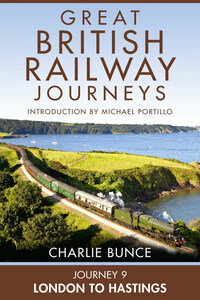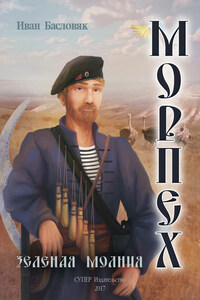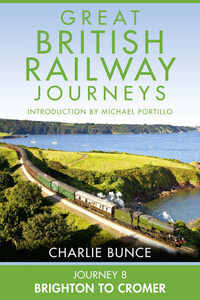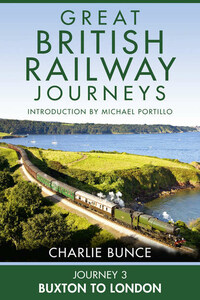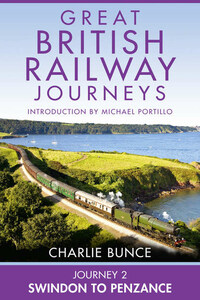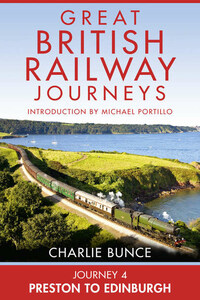FOREWORD
by Michael Portillo
Like most people, I thought travel an adventure when I was a child, and most of those adventures were by train. There were still some steam trains around for me. There was a tank engine-hauled service from Belmont to Harrow and Wealdstone, close to where I grew up. My eldest brother, Charles, would take me on the âBelmont Rattlerâ, and I remember the panting engine, the smoke and my excitement.
For summer holidays we would go to the Isle of Wight by electric train from Waterloo, but from Ryde we would pick up the steam service along the islandâs east coast. The tunnel beneath the Boniface Downs would fill with the pungent stench of steam locomotive just before we pulled into Ventnor.
Then there was the annual excursion to my motherâs hometown of Kirkcaldy. My parents were not well off, so we took the overnight train without sleeper reservations, travelling second class, sitting upright, sustained by Lucozade and peanut butter sandwiches. On at least one occasion it took 13 hours, and the service was known, to our sardonic amusement even then, as the Starlight Special.
After childhood, trains became mere tools for me. As a politician I visited most places to campaign, cut a ribbon or make a speech. The train got me there, or got me there late. The glamour was gone, and I was all too ready to criticise the lateness, the absence of the refreshment trolley or the failure of the air conditioning.
Now I find myself drawn to the railways once again. Making the two series of Great British Railway Journeys has meant spending almost 100 days travelling the length and breadth of the country and has brought back for me the idea of railway journey as adventure. Catching the train has been a key part of the experience, not merely a chore.
I was always travelling to see. I journeyed with curiosity and optimism, and I was rarely disappointed.
My guide was a Victorian called George Bradshaw. In 1839 he started producing railway timetables and then a handbook to journeying through Britain by train. Even though I have travelled most of the routes before, this book shone an endlessly fascinating light on everywhere I visited. I have studied the Victorian period at school and university, but no document that I have read before is quite as revealing of the Victorian outlook as this travel guide.
Former minister Michael Portillo revisits his love of railways.
© Steve Peskett
Bradshawâs generation was highly excited by its central role in a world that was moving forward at an exhilarating pace. His wonder and pride spill from every page. Enthusiastic, patriotic, opinionated, he writes in an era unrestrained by egalitarianism, let alone political correctness. His age values reason, experimentation and excellence. It is serious and largely unsentimental. For Bradshaw there was no shame in imperialism, no consideration of taste to restrain his bombast. Manchester manufacturers, he records with pride, could import the cotton crop from India, spin it and export textiles that would then undercut local production in India. London, he says, is the greatest city that exists, or has ever existed. He is right that London stood at the heart of an empire that exceeded that of the Pharaohs or Caesars, and considering Britainâs mastery of technology there was no serious competition to be found anywhere in the worldâs history.
Bradshawâs first enthusiasm was for canals, a prodigious achievement in themselves with a great impact on business. But the railways were faster and more versatile. Above all they were for the masses. Without large numbers of passengers they were uneconomic. They altered the geography of Britain by making places accessible, and they transformed the social landscape because people of modest means could travel.
The speed of the change is difficult even for us to grasp, because although the mobile phone and computer have led to a revolution over the last 20 years, modern-day Britain doesnât undergo physical change as fast as Victorian Britain did. The worldâs first intercity line opened between Liverpool and Manchester in 1830. Twenty years later over 6,000 miles of track had been laid, reaching all but the remotest parts of the country. Railways sprang up everywhere. Some important lines were built in their entirety in just two years. Although steam engines were used in construction, most of the work was done by hand. Thousands of navvies occupied camps along the route, and dug the cuttings and raised up the stones for the viaducts. We would have to visit modern Shanghai, perhaps, to gain any understanding of the speed of change and the scale of the undertaking.
The handbookâs itineraries follow the tracks. Towns are listed not alphabetically but in their order along the main lines and branch lines. I have been asked a lot whether I didnât find that many of Bradshawâs routes have gone. Some have, of course. But I think I was more struck but the degree of continuity between then and now. Britain today, despite its post-war motorways, depends upon an infrastructure laid down by the Victorians. They built to last, and often grandly. As the refurbishment of St Pancras has shown, the best thing to be done with a Victorian building is simply to undo the damage of decades caused by smoke and rain and, particularly, cheapskate makeovers. Stand on Waterloo Bridge with Bradshawâs book and you may find that the finest buildings today are still the ones that he picked out: Saint Paulâs cathedral, Somerset House and Parliament.
